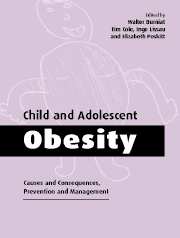Book contents
- Frontmatter
- Contents
- List of contributors
- Foreword
- Preface
- Part I Causes
- Part II Consequences
- Part III Prevention and management
- 12 Prevention
- 13 Home-based management
- 14 Dietary management
- 15 Management through activity
- 16 Psychotherapy
- 17 Drug therapy
- 18 Surgical treatment
- 19 Interdisciplinary outpatient management
- 20 Interdisciplinary residential management
- 21 The future
- Index
13 - Home-based management
Published online by Cambridge University Press: 02 November 2009
- Frontmatter
- Contents
- List of contributors
- Foreword
- Preface
- Part I Causes
- Part II Consequences
- Part III Prevention and management
- 12 Prevention
- 13 Home-based management
- 14 Dietary management
- 15 Management through activity
- 16 Psychotherapy
- 17 Drug therapy
- 18 Surgical treatment
- 19 Interdisciplinary outpatient management
- 20 Interdisciplinary residential management
- 21 The future
- Index
Summary
Introduction
The treatment of obesity has a depressing reputation. The reported levels of success are low at all ages (Serdula et al., 1993; Lake et al., 1997) with many obese children continuing life as obese adults. Yet, most of us know overweight or obese individuals, both adults and children, who slimmed successfully without formal ‘treatment’ and who have continued to maintain normal physique. Data suggest that, particularly amongst younger obese children without an obese parent, spontaneous slimming is a frequent occurrence (Whitaker et al., 1997). Thus there seems something anachronistic about the effect of treatment in obesity.
Goals of slimming
One of the reasons why the outlook for the treatment of obesity has such a poor reputation is a lack of definition of what is perceived as successful treatment. Ideally, the return to, and maintenance of, normal fatness would be the goal of all treatment. However, many children and adults are so obese before they embark on treatment that to return to normal fatness may be an impossible dream. Too often, clinicians are confronted by totally unrealistic expectations: the social and nutritional crisis created by an obese girl's appointment as bridesmaid in 8 weeks time, for example. Failure to achieve normal body weight in time is seen as total failure of the slimming process. Yet … Mission Impossible?
The goal of all weight-control programmes should be some reduction in excess fat even if this does not result in normal nutrition.
- Type
- Chapter
- Information
- Child and Adolescent ObesityCauses and Consequences, Prevention and Management, pp. 270 - 281Publisher: Cambridge University PressPrint publication year: 2002
- 1
- Cited by



